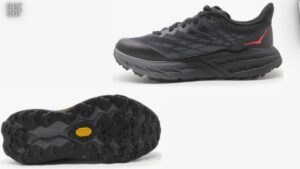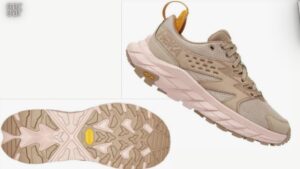If you’re an outdoor enthusiast gearing up for your next adventure, choosing the right footwear can make all the difference. When it comes to hiking and trekking, two popular options from HOKA ONE ONE stand out: the Anacapa Aero Low Hiking Boot and the HOKA ONE ONE Trekking Shoes. But which one is the right fit for you? Let’s dive into the details and compare these two options to help you make an informed decision.

Comfort and Support:
Both the Anacapa Aero Low Hiking Boot and the HOKA ONE ONE Trekking Shoes are designed with comfort and support in mind. The Anacapa Aero features a low-cut design with a breathable mesh upper, providing ample ventilation during your hikes. On the other hand, the Trekking Shoes offer a more traditional shoe design with a durable synthetic upper.
Traction and Stability:
When it comes to traction and stability on varied terrain, both options excel. The Anacapa Aero boasts a Vibram® Megagrip outsole, offering excellent grip on both wet and dry surfaces. Meanwhile, the Trekking Shoes feature a rugged outsole with multidirectional lugs, providing reliable traction on rocky trails and slippery slopes.
Durability and Protection:
Durability is key when it comes to outdoor footwear, and both the Anacapa Aero and Trekking Shoes are built to last. The Anacapa Aero is constructed with durable materials, including a reinforced toe cap and heel overlay for added protection against rocks and debris. Similarly, the Trekking Shoes feature a sturdy construction, with a protective toe cap guarding against accidental stubs.
Weight and Flexibility:
For long hikes and treks, lightweight and flexibility are essential factors to consider. The Anacapa Aero shines in this department, thanks to its lightweight construction and flexible midsole, allowing for natural foot movement. Conversely, the Trekking Shoes offer a balance between support and flexibility, making them suitable for various outdoor activities.
Versatility:
While both options are geared towards hiking and trekking, they each have their own unique features that cater to different preferences and terrains. The Anacapa Aero is ideal for warm-weather hikes and shorter trails, thanks to its breathable design and low-cut silhouette. On the other hand, the Trekking Shoes are versatile enough to tackle a wide range of terrain, from rugged mountain trails to urban adventures.

So.
Ultimately, choosing between the HOKA ONE ONE Anacapa Aero Low Hiking Boot and the Trekking Shoes comes down to your specific needs and preferences. If you prioritize lightweight comfort and breathability for shorter hikes in warm weather, the Anacapa Aero may be the perfect fit for you. However, if you’re seeking a versatile option that offers durability and traction across various terrains, the Trekking Shoes are worth considering.
Whichever option you choose, both the Anacapa Aero and Trekking Shoes are sure to enhance your outdoor adventures with their innovative designs and reliable performance.
External Resources:
- ==>> Go here to check out HOKA ONE ONE shoes – Explore the latest collection of hiking and trekking shoes from HOKA ONE ONE.
Remember, the right footwear can make all the difference in your outdoor experiences, so choose wisely and embark on your next adventure with confidence
Tabular
Here’s a comparison table highlighting the key features, pros, and cons of the HOKA ONE ONE Anacapa Aero Low Hiking Boot and Trekking Shoes:
| Feature | HOKA ONE ONE Anacapa Aero Low Hiking Boot | HOKA ONE ONE Trekking Shoes |
|---|---|---|
| Design | Low-cut hiking boot with breathable mesh upper | Traditional shoe design with durable synthetic upper |
| Comfort | Ample cushioning and support for all-day comfort | Responsive cushioning and support for long hikes |
| Traction | Vibram® Megagrip outsole for excellent grip | Rugged outsole with multidirectional lugs |
| Durability | Durable materials with reinforced toe and heel overlay | Sturdy construction for long-lasting performance |
| Weight | Lightweight design for easy movement | Balanced weight for stability and support |
| Waterproofing | Water-resistant materials for light rain protection | Limited water resistance, not fully waterproof |
| Versatility | Suitable for warm-weather hikes and shorter trails | Versatile for various terrains and outdoor activities |
| Pros | – Lightweight and breathable
– Comfortable cushioning – Excellent grip on diverse terrain |
– Versatile for different outdoor activities
– Durable construction – Reliable traction on varied terrain |
| Cons | – Limited water resistance
– Less ankle support compared to higher-cut boots |
– Limited waterproofing
– May feel bulky for some users – Not suitable for extreme cold weather |
Digging Deeper: Other Key Factors To Consider And Pro Tips Making A Lasting Impact
Additional Considerations:
Before making your final decision, there are a few additional factors to consider:
Fit and Sizing:
Both the Anacapa Aero and Trekking Shoes come in a range of sizes to accommodate different foot shapes and widths. It’s essential to try them on and ensure a proper fit, especially if you have specific foot requirements or wear orthotics.
Waterproofing:
While neither the Anacapa Aero nor the Trekking Shoes are fully waterproof, they offer some degree of water resistance to keep your feet dry in light rain or damp conditions. If you anticipate hiking in wetter environments, you may want to consider investing in waterproofing treatments or opting for a dedicated waterproof hiking boot.
Terrain Specificity:
Consider the type of terrain you’ll be encountering on your hikes and treks. If you primarily stick to well-maintained trails and moderate terrain, the Anacapa Aero’s lightweight design may be sufficient. However, if you venture into rugged backcountry terrain or encounter unpredictable weather conditions, the added durability and stability of the Trekking Shoes may be advantageous.
Personal Preference:
Ultimately, the best hiking and trekking footwear for you is the one that feels most comfortable and supportive on your feet. It’s essential to trust your instincts and prioritize your comfort and performance over brand loyalty or aesthetics.
Final Thoughts:
Whether you opt for the HOKA ONE ONE Anacapa Aero Low Hiking Boot or the Trekking Shoes, you can rest assured knowing that you’re investing in high-quality footwear engineered for outdoor adventures. Both options offer a winning combination of comfort, durability, and performance to help you tackle any trail with confidence.
So lace up your boots or shoes, grab your backpack, and hit the trails knowing that you’re equipped with the gear you need to make lasting memories in the great outdoors.
External Resources:
- ==>> Go here to check out HOKA ONE ONE shoes – Explore the latest collection of hiking and trekking shoes from HOKA ONE ONE.
With the right footwear at your disposal, there’s no limit to where your outdoor adventures may take you. Happy hiking and trekking!
FAQs
Here are some frequently asked questions (FAQs) about hiking and trekking footwear:
1. Are the HOKA ONE ONE Anacapa Aero Low Hiking Boot and Trekking Shoes suitable for beginners?
Yes, both options are suitable for beginners. They offer a balance of comfort, support, and traction, making them ideal for those new to hiking and trekking.
2. Can I use the HOKA ONE ONE Anacapa Aero and Trekking Shoes for other outdoor activities besides hiking?
While these shoes are primarily designed for hiking and trekking, they can also be used for other outdoor activities such as walking, trail running, and light backpacking.
3. Are the HOKA ONE ONE Anacapa Aero and Trekking Shoes true to size?
HOKA ONE ONE footwear tends to run true to size, but it’s always recommended to try them on or refer to the brand’s sizing guide to ensure the best fit for your feet.
4. How do I care for and maintain my hiking and trekking shoes?
To prolong the life of your footwear, it’s essential to clean them regularly and store them in a cool, dry place away from direct sunlight. Additionally, consider waterproofing treatments to enhance water resistance and protect the materials from wear and tear.
5. Can I use aftermarket insoles or orthotics with the HOKA ONE ONE Anacapa Aero and Trekking Shoes?
Yes, both options provide removable insoles, allowing you to customize the fit and support with aftermarket insoles or orthotics if needed.
6. Are the HOKA ONE ONE Anacapa Aero and Trekking Shoes suitable for long-distance hiking?
While both options offer comfort and support, long-distance hiking may require additional features such as increased cushioning and ankle support. Consider your specific needs and preferences when selecting footwear for extended hikes.
7. How do I break in my hiking and trekking shoes?
To break in your shoes effectively, start by wearing them for short walks or hikes to allow the materials to mold to your feet gradually. Avoid diving into long, strenuous hikes until your shoes feel comfortable and adequately broken in.
8. Can I use the HOKA ONE ONE Anacapa Aero and Trekking Shoes in cold weather or snow?
While these shoes are suitable for mild to moderate weather conditions, they may not provide sufficient insulation for extreme cold or snowy environments. Consider wearing insulated socks or opting for specialized winter footwear for cold weather adventures.
9. Are the HOKA ONE ONE Anacapa Aero and Trekking Shoes suitable for flat feet or high arches?
Both options provide ample cushioning and support, making them suitable for individuals with various foot arch types. However, those with specific foot conditions may benefit from consulting a podiatrist or trying on different shoes to find the best fit.
10. Can I use the HOKA ONE ONE Anacapa Aero and Trekking Shoes for backpacking trips?
While these shoes offer support and durability, backpacking trips often require footwear with additional ankle support and stability. Consider opting for hiking boots or shoes specifically designed for backpacking if you plan to carry heavy loads over long distances.
11. How do I know when it’s time to replace my hiking and trekking shoes?
It’s time to replace your shoes when you notice significant wear and tear, loss of cushioning or support, or signs of structural damage such as sole separation or torn uppers. As a general rule, consider replacing your footwear every 300 to 500 miles of use, depending on the terrain and conditions.
12. Can I use the HOKA ONE ONE Anacapa Aero and Trekking Shoes for trail running?
While these shoes offer comfort and traction suitable for trail running, dedicated trail running shoes may provide better agility and responsiveness for faster-paced activities. Consider your running style and preferences when selecting footwear for trail running.
13. Are the HOKA ONE ONE Anacapa Aero and Trekking Shoes vegan-friendly?
HOKA ONE ONE offers a range of footwear options, including some that are vegan-friendly. Check the product descriptions or contact customer support to confirm if the Anacapa Aero and Trekking Shoes meet your specific dietary preferences.
14. Can I use the HOKA ONE ONE Anacapa Aero and Trekking Shoes for water crossings or wet conditions?
While both options offer some degree of water resistance, they are not designed for extended immersion in water. Use caution when navigating wet terrain or water crossings, and consider waterproofing treatments or wearing water-resistant socks for added protection.
15. Are the HOKA ONE ONE Anacapa Aero and Trekking Shoes suitable for wide feet?
HOKA ONE ONE offers some styles in wider widths to accommodate individuals with wider feet. Check the product descriptions or try on different sizes to find the best fit for your foot width.
Conclusion:
Both the HOKA ONE ONE Anacapa Aero Low Hiking Boot and Trekking Shoes offer unique features and benefits tailored to different hiking and trekking preferences. While the Anacapa Aero excels in lightweight comfort and breathability, the Trekking Shoes provide versatility and durability across various terrains.
Ultimately, the right choice depends on your specific needs, terrain preferences, and comfort requirements. Consider factors such as ankle support, waterproofing, and traction to determine which option best suits your outdoor adventures.
Do you have any further questions or need assistance in making your decision? Feel free to ask.

Hey there, I’m Mike, the brains behind Reviewmedium.com. When I’m not busy running the show, you can usually find me obsessing over my ever-growing collection of shoes. Yep, I’m that guy who’s pretty picky about what goes on his feet.
Over the years, I’ve dipped my toes into a wide range of brands – from the classics like Timberland and Converse to the trendsetters like Nike and Adidas. You name it, I’ve probably laced it up.
My journey as a shoe aficionado inspired me to create this blog. Here, I spill the beans on all things footwear, straight from my hands-on experience and meticulous research.
And hey, if you’re here, chances are you share the same passion for kicks as I do. Well, you’re in luck! This blog is your ultimate destination for everything shoe-related. From in-depth reviews to handy buying guides, consider it your go-to resource for stepping up your shoe game. So kick back, relax, and let’s dive into the world of footwear together.
Related Posts
- Should I donate new or used shoes?
Today I want to talk about shoe Donating: New vs. Used. Hey there. So, you're…
- Why donate shoes? (Explained)
You may have a pair of shoes tucked away in your closet that you haven't…
- Can sustainable shoes be stylish?(Explained)
Hey there, shoe lover. If you're anything like me, you probably appreciate a good pair…
- Why Are Sustainable Shoes More Expensive?
Hey there. Have you ever wondered why sustainable shoes tend to come with a higher…
- Why do some consumers believe sustainable shoes aren't as durable as traditional ones?
Today I want to talk about Why Sustainable Shoes Are Often Misunderstood. Hey there, shoe…
- Why Sustainable Shoes Aren't Always Seen as Fashionable (And Why They Should Be)
If you've ever browsed the aisles of a shoe store or scrolled through online catalogs,…
- Who accepts shoe donations?
Welcome back, shoe enthusiasts. today I want to talk about Where You can Donate Your…
- Why You Should Support Sustainable Shoe Brands
Today I want to talk about Why we should support sustainable shoe brands. Hey there.…